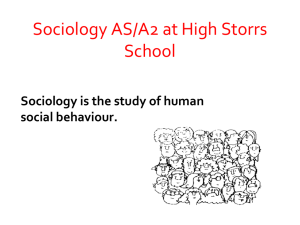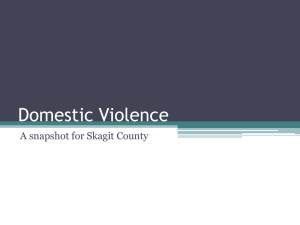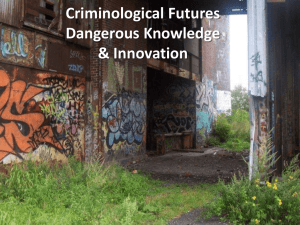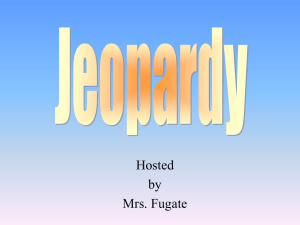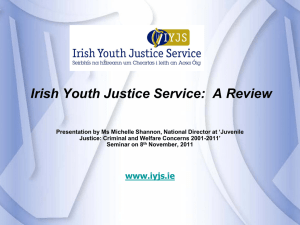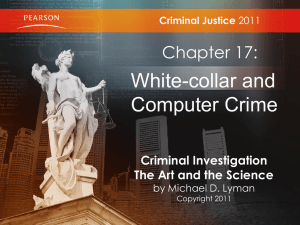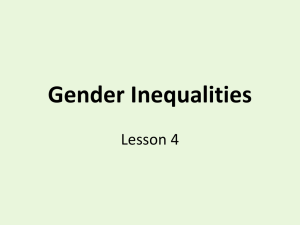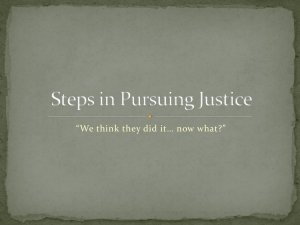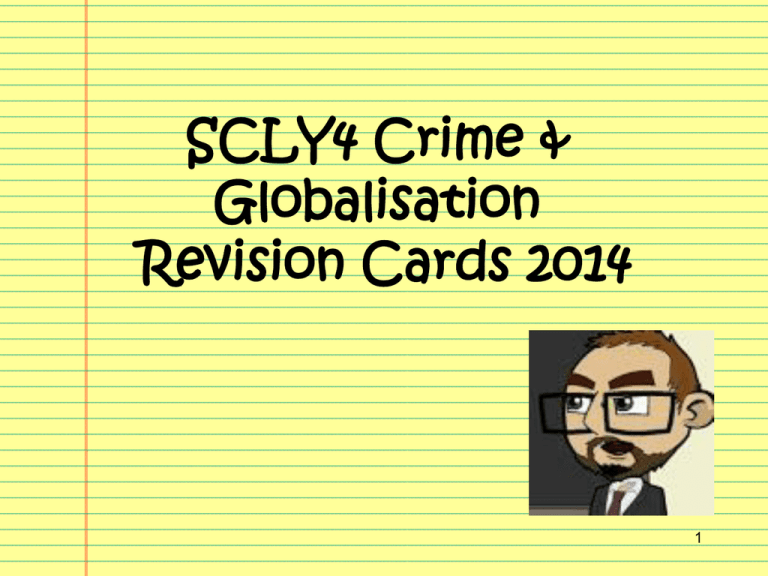
SCLY4 Crime &
Globalisation
Revision Cards 2014
1
7. Globalisation and Crime
Includes:
•
•
•
•
•
What is globalisation?
The extent of the global crime economy
Globalisation and :risk consciousness, capitalism and organisation
Green crime
Human rights and state crimes
Think about:
Power, harm and interconnectedness
Crimes of the powerful
•
•
•
•
Nation states/large
corporations power
Cause major harm
Hidden crime
Unpunished crime
Zemiology
•
•
•
Beyond traditional
criminology
How crime is defined
The study of harm
Crimes without frontiers
•
•
Beyond national
boundaries
Global connections =
more opportunities
2
How to focus on this topic..
•
Globalisation is a ‘game-changer’ for the study of crime
•
Globalisation = new forms of crime/new opportunities
•
Global crime = a challenge for ‘nation-states’ and law making/jurisdiction (hard
to police)
•
Global crimes by powerful groups = able to define laws (to serve selves), able
to hide crimes, able to escape punishment
•
Global crimes = high level of harm/damage (to environment or to citizens)
You can use these as strands to return to again and again in
your analysis of them.
These revision cards try to focus on these strands for you.
3
The extent of Global crime
What is globalisation?
• The increasing interconnectedness of
societies
•
‘the widening, deepening and speeding
up of world wide interconnectedness’
(Held)
•
causes: global media, cheap travel, ICT,
migration, business links
•
Crime across national borders
Global risk consciousness (Beck)
•
•
•
•
•
Fears of harm/need protection
Media exaggeration/moral panics
Immigration worries (welfare/jobs)
Led to tighter border controls
9/11 terrorism and consequences
The level of Global crime
• Manuel Castells – global crime
economy = £1 trillion per year
•
•
•
•
•
•
•
•
•
•
Arms trafficking
Trafficking nuclear materials
People smuggling/illegal immigrants
Prostitution/slavery
Sex tourism
Cyber crimes (fraud/pornography)
Terrorism
Green crime
Demand (rich west)
Drugs trade
+ Supply (3rd world)
Money laundering
Capitalism and crime
•
•
•
•
Ian Taylor – greater inequality = crime
Businesses (TNCs) switch to low-wage
countries = poverty = insecurity +
frustration = poor people turn to crime
New crim. Opportunities for rich and
powerful = insider trading/tax
avoidance/moving funds
Capitalist employers using foreign4
labour + breaching laws
New patterns of criminal organisation
GLOCAL organisation
McMafia
•
Hobbs & Dunningham
•
Glenny
•
Global economic changes = local crime
organisation
Individuals with contacts form a ‘hub’
Loose-knit networks – NOT hierarchy
(different to subcultures and
traditional ‘mafia’ style gangs)
Key root = local context
But has global connections
Each locality will affect the nature of
the criminal organisation (global crime
filtered through a local lens)
•
Organisations emerging after fall of
communism in 1989
Deregulation of global markets
Communism falls = free market except
for natural resources, ie) oil
Russian govt controlled these and kept
prices low (communist officials bought
these for next to nothing)
They sold them abroad = high price
Became very rich/powerful – oligarchs
Ex-KGB/former convicts formed
mafias - used to protect this new
wealthy class, ie) Chechen Mafia
Not like Italian mafia – kin/hierarchy
These mafias were purely economic/
driven by greed
Chechen Mafia became a brand –
ruthless/protection rackets
Exported brand elsewhere
Built links around the world
5
•
•
•
•
•
•
Example – old industry shut because of
global competition = nocturnal economy
in Sunderland – bouncers/body capital
Evaluation
• Not clear if these hubs are ‘new’
• Older structures may still run alongside
•
•
•
•
•
•
•
•
•
•
•
Green Crime
1. Global risk society and environment
•
•
•
•
•
Crime against the environment
Planet is a single eco-system (goes
beyond national boundaries)
Examples: air pollution, water pollution,
nuclear disasters
Mainly ‘man-made’ risks today
Beck – manufactured risks are damaging
humanity (made by industry/transport
etc)..go beyond national boudaries
3.Types of Green Crime (Nigel South)
Primary crimes
Direct result of destroying Earth’s resources:
(a) crimes of air pollution
(b) crimes of deforestation
(c) crimes of species decline/animal rights
(d) crime of water pollution
Secondary crimes
Result from flouting the rules to prevent
disasters:
(a) State violence against opp. Groups
eg) French Govt – Greenpeace ship attack
(b) Hazardous waste and organised crime
eg) business dispose of waste illegally, ship
waste to 3rd world/role of ‘ecomafia’ Italy
2. Green Criminology
Traditional criminology
• Harm to the environment may be
defined as ‘legal’ though
• Traditional criminology is tied to
‘criminal law’ and green crime ignored
• Situ & Emmons – see env. Crime as ‘an
unauthorised act or omission that
violates the law’ – a definition that is
limited by the law and who control it
Green criminology (Rob White)
• Focus on harm rather than law
• Some of worst harm = not illegal
• This is transgressive criminology that
moves beyond traditional criminology
• Different countries have diff. laws
• Looks at crimes of the powerful – like
Marxists note invisible/escape punish.
2 views of harm
• Anthropocentric view – human view –
man can exploit envt. (businesses)
• Ecocentric view – humans and envt.
are linked…envt. needs protecting
6
from global capitalism
Examples of ‘Green’ crimes/studies
Evaluation
Bhopal disaster
• 1984 - India – Union Carbide
• Leaking cyanide – safety failure
• 30 tons of gas = 20’000 deaths and 120’000
continue suffering
• recognises importance of
global issues
Air pollution – from industry/transport
Deforestation – Amazon for beef cattle
Water Pollution – 25 million die each yr from
contaminated water (toxic waste and
untreated sewage)
Day – those who oppose governments
supporting nuclear power/arms are seen as
‘enemies of the state’ (Greenpeace)
Walters– ‘ocean floor has been a radioactive
rubbish dump for decades’
• shows where law is lacking
where harm is concerned
• reveals how the powerful
define laws and hide crimes
• hard to define the
boundaries of ‘green
criminology’
• definitions are value-laden
with moral criteria used
Bridgland – 2004 Tsunami = barrels of
radioactive waste dumped by European
countries washed up by Somalia
Rosoff – notes how cheap disposing of toxic
waste in 3rd World coiuntries
7
The extent of ‘state crime’
What are state crimes?
•
•
•
Crimes of the powerful - ‘state
organised crime’ (Chambliss)
Green & Ward ‘illegal or deviant
activities perpetrated by, or with
complicity of, state agencies’
The state is able to define what is
criminal
Examples – genocide, torture,
imprisonment without trial, assassination
McLaughlin – 4 categories of state crime
• Political crimes
• Crime by security/police forces
• Economic crimes
• Social/cultural crimes
The extent of state crime
Michalowski & Kramer argue that these
crimes are s0 serious because:
•
•
•
•
The state has a monopoly on violence
– potential to cause much harm
It can conceal it’s crimes and avoid
punishment
It is hard to police the actions of
these states (by other states)
It makes laws and can use them to
control/persecute their enemies
8
The extent of ‘state crime’
Example of state crimes?
•
Cambodia (1975-8) – Pol Pot’s Khmer
Rouge government killed 2 million
people
The Violation of Human Rights
•
•
Natural Rights/Civil Rights
Protection from state
Schwendinger & Schwendinger
• Crime = level of violation of human
rights (harm/zemiology)
• States denying basic human rights
•
Nazi Germany – persecution of Jews,
the Final Solution
•
Guantanamo Bay – US using excessive
methods with terror ‘suspects’
•
•
Iraq – Saddam Hussein attacking the
Kurds in Northern Iraq
•
Vietnam – My Lai massacre of 400
civilians by US troops during Vietnam
war
•
Hiroshima/Nagasaki – Atomic bombs
dropped by US on Japanese cities in
WW2
Crimes include: racism, sexism,
homophobia, economic exploitation
Evaluation
• Cohen – not objective/easy to explore
‘economic exploitation’
• There is limited agreement on what is
classed as a human right
9
How states crimes become possible
States ‘hiding’ their crimes
•
Cohen – state crimes are being
explored more within criminology and
notes how states try to hide/
legitimate their crimes
Denial
• 3 stages – didn’t happen/its not what
it seems/its justified
Neutralisation theory
• Applies Matza’s model for justifying
deviant behaviour
•
Techniques : denial of victim, denial
of injury, denial of responsibility,
condemning the condemners, appeal
to higher loyalty
Negotiation/social construction
State crime as acceptable
•
How normal people perform evil acts
on behalf of states
Kelman & Hamilton – 3 factors that
create ‘crimes of obedience’:
•
•
•
Authorisation – given permission =
duty to obey
Routinisation – role/detached
Dehumanisation – enemy seen as subhuman (linked to propaganda)
Dehumanisation and modernisation
•
•
Science and technology help states to
commit these crimes (Bauman)
They dehumanise and turn mass
murder in a routine/admin task
10
Globalisation & Crime (bring together)
Evaluation
• Issue of defining crime
• Objectivity/values
• Political flavour
(committed sociology)
STATE CRIME
•
•
•
•
•
•
GLOBAL
CRIME
Levels/types(Castells)
Risk consciousness
Global capitalism
Examine
Globalisation
& Crime
What are state crimes?
The level of harm
Examples
Violations of human rights
How states conceal crimes (denial)
How states make such crime acceptable
Organisations
• Glocal
• McMafia
GREEN CRIME
•
•
•
•
•
Global risk
consciousness
Green criminology +
harm
Types of green crime
Examples
Evaluation
11

